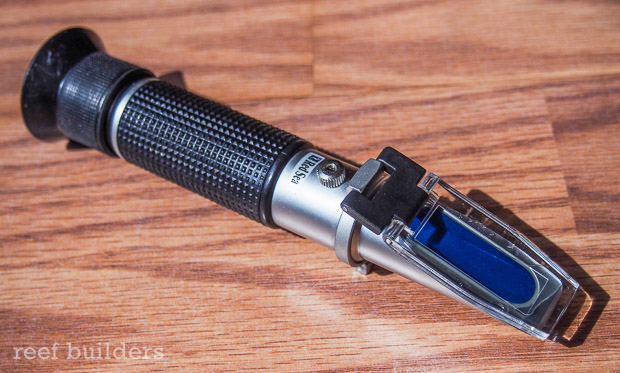A couple years ago we were really thrilled when D-D came out with the first ever aquarium refractometer that is calibrated for seawater salinity, a true aquarium salt measurement device that trumped all the salt-water refractometers that we were using before. Now Red Sea has released their own aquarium-tuned refractometer and for a myriad of reasons, this is now our de-facto aquarium salinity measurement device.
What makes the Red Sea refractometer such a stand out device is that it was built from the ground up with aquarium use in mind. Subtle touches like improved optics and a mild diffusing surface to the cover plate both enhance the viewing of the seawater salinity scale and improve the incoming of light into the refracting device.

Being able to see the measurement scale is nice and all, but only so long as what you’re reading is an accurate scale of seawater salinity calibrated for typical aquarium temperatures. Where D-D’s refractometer raised the accuracy bar by going from saltwater to seawater salinity, Red Sea has further refined the mark by not only developing their own seawater salinity scale, but also fine tuning it for temperatures that aquarists typically encounter.
D-D’s refractomer is calibrated for use in 20C/68F which is perfect for use in cool and coldwater marine aquariums but I don’t know about you but we like to keep tropical marine animals which prefer an average temperature of 77 degrees Fahrenheit. To that end Red Sea’s refractometer is calibrated for use at 25C/77F and it is therefore the only tropical marine aquarium refractometer on the market – wild huh?

The difference between a refractometer designed for saltwater and seawater is about 1.5 PPT and the difference between one calibrated for seawater at 68F and 77F is another 1.5 PPT. This means that if you’re using a standard cheapo refractometer your salinity could be off by as much as 3 PPT.
If you’re aiming for a salinity of 33PPT but not using a seawater refractometer calibrated for average aquarium temperatures your salinity could be off by nearly 10%; your calcium is not low, your salinity is! If you are measuring 380ppm calcium but your salinity is actually 30ppt, you don’t need to add more calcium or buffer, you just need to add more salt mix to add more of everything that makes up the salts in seawater.

In a way we weren’t really surprised to go around measuring the salinity of our aquariums with Red Sea’s new refractometer and discovering they were all a little low, since we had already gone through this with the D-D refractometer. But more than a month of running our coral aquariums at desired salinity read by the Red Sea refractometer and we’re seeing increased coral growth and vitality, and definitely a much more stable calcium and alkalinity balance.
As important as salinity is to keeping a marine aquarium, we really suck at measuring it and with their new refractometer Red Sea has gifted the aquarium hobby with much improved chance of success and hopefully much fewer headaches regarding mineral balance. [Red Sea]
FTC regulations require that we inform you that we were given this product for review, but our opinion of a product is never affected by how we acquire them.



